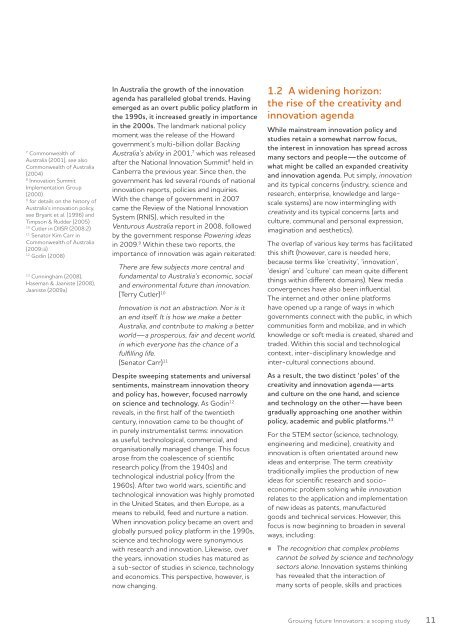GrowinG Future innovators - ARC Centre of Excellence for Creative ...
GrowinG Future innovators - ARC Centre of Excellence for Creative ...
GrowinG Future innovators - ARC Centre of Excellence for Creative ...
You also want an ePaper? Increase the reach of your titles
YUMPU automatically turns print PDFs into web optimized ePapers that Google loves.
7 Commonwealth <strong>of</strong><br />
Australia (2001), see also<br />
Commonwealth <strong>of</strong> Australia<br />
(2004)<br />
8 Innovation Summit<br />
Implementation Group<br />
(2000)<br />
9 <strong>for</strong> details on the history <strong>of</strong><br />
Australia’s innovation policy,<br />
see Bryant et al. (1996) and<br />
Timpson & Rudder (2005)<br />
10 Cutler in DIISR (2008:2)<br />
11 Senator Kim Carr in<br />
Commonwealth <strong>of</strong> Australia<br />
(2009:iii)<br />
12 Godin (2008)<br />
13 Cunningham (2008),<br />
Haseman & Jaaniste (2008),<br />
Jaaniste (2009a)<br />
In Australia the growth <strong>of</strong> the innovation<br />
agenda has paralleled global trends. Having<br />
emerged as an overt public policy plat<strong>for</strong>m in<br />
the 1990s, it increased greatly in importance<br />
in the 2000s. The landmark national policy<br />
moment was the release <strong>of</strong> the Howard<br />
government’s multi-billion dollar Backing<br />
Australia’s ability in 2001, 7 which was released<br />
after the National Innovation Summit 8 held in<br />
Canberra the previous year. Since then, the<br />
government has led several rounds <strong>of</strong> national<br />
innovation reports, policies and inquiries.<br />
With the change <strong>of</strong> government in 2007<br />
came the Review <strong>of</strong> the National Innovation<br />
System (RNIS), which resulted in the<br />
Venturous Australia report in 2008, followed<br />
by the government response Powering ideas<br />
in 2009. 9 Within these two reports, the<br />
importance <strong>of</strong> innovation was again reiterated:<br />
There are few subjects more central and<br />
fundamental to Australia’s economic, social<br />
and environmental future than innovation.<br />
(Terry Cutler) 10<br />
Innovation is not an abstraction. Nor is it<br />
an end itself. It is how we make a better<br />
Australia, and contribute to making a better<br />
world—a prosperous, fair and decent world,<br />
in which everyone has the chance <strong>of</strong> a<br />
fulfilling life.<br />
(Senator Carr) 11<br />
Despite sweeping statements and universal<br />
sentiments, mainstream innovation theory<br />
and policy has, however, focused narrowly<br />
on science and technology. As Godin 12<br />
reveals, in the first half <strong>of</strong> the twentieth<br />
century, innovation came to be thought <strong>of</strong><br />
in purely instrumentalist terms: innovation<br />
as useful, technological, commercial, and<br />
organisationally managed change. This focus<br />
arose from the coalescence <strong>of</strong> scientific<br />
research policy (from the 1940s) and<br />
technological industrial policy (from the<br />
1960s). After two world wars, scientific and<br />
technological innovation was highly promoted<br />
in the United States, and then Europe, as a<br />
means to rebuild, feed and nurture a nation.<br />
When innovation policy became an overt and<br />
globally pursued policy plat<strong>for</strong>m in the 1990s,<br />
science and technology were synonymous<br />
with research and innovation. Likewise, over<br />
the years, innovation studies has matured as<br />
a sub-sector <strong>of</strong> studies in science, technology<br />
and economics. This perspective, however, is<br />
now changing.<br />
1.2 A widening horizon:<br />
the rise <strong>of</strong> the creativity and<br />
innovation agenda<br />
While mainstream innovation policy and<br />
studies retain a somewhat narrow focus,<br />
the interest in innovation has spread across<br />
many sectors and people—the outcome <strong>of</strong><br />
what might be called an expanded creativity<br />
and innovation agenda. Put simply, innovation<br />
and its typical concerns (industry, science and<br />
research, enterprise, knowledge and largescale<br />
systems) are now intermingling with<br />
creativity and its typical concerns (arts and<br />
culture, communal and personal expression,<br />
imagination and aesthetics).<br />
The overlap <strong>of</strong> various key terms has facilitated<br />
this shift (however, care is needed here,<br />
because terms like ‘creativity’, ‘innovation’,<br />
‘design’ and ‘culture’ can mean quite different<br />
things within different domains). New media<br />
convergences have also been influential.<br />
The internet and other online plat<strong>for</strong>ms<br />
have opened up a range <strong>of</strong> ways in which<br />
governments connect with the public, in which<br />
communities <strong>for</strong>m and mobilize, and in which<br />
knowledge or s<strong>of</strong>t media is created, shared and<br />
traded. Within this social and technological<br />
context, inter-disciplinary knowledge and<br />
inter-cultural connections abound.<br />
As a result, the two distinct ‘poles’ <strong>of</strong> the<br />
creativity and innovation agenda—arts<br />
and culture on the one hand, and science<br />
and technology on the other—have been<br />
gradually approaching one another within<br />
policy, academic and public plat<strong>for</strong>ms. 13<br />
For the STEM sector (science, technology,<br />
engineering and medicine), creativity and<br />
innovation is <strong>of</strong>ten orientated around new<br />
ideas and enterprise. The term creativity<br />
traditionally implies the production <strong>of</strong> new<br />
ideas <strong>for</strong> scientific research and socioeconomic<br />
problem solving while innovation<br />
relates to the application and implementation<br />
<strong>of</strong> new ideas as patents, manufactured<br />
goods and technical services. However, this<br />
focus is now beginning to broaden in several<br />
ways, including:<br />
The recognition that complex problems<br />
cannot be solved by science and technology<br />
sectors alone. Innovation systems thinking<br />
has revealed that the interaction <strong>of</strong><br />
many sorts <strong>of</strong> people, skills and practices<br />
Growing future Innovators: a scoping study 11




![Plebiscite (Riegert chapter) revised FINAL [Feb 14].pdf](https://img.yumpu.com/8710373/1/190x245/plebiscite-riegert-chapter-revised-final-feb-14pdf.jpg?quality=85)